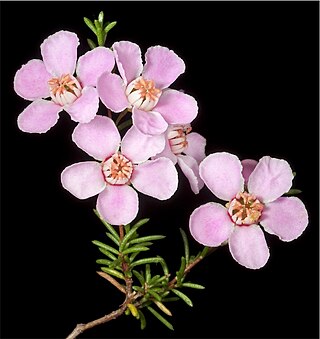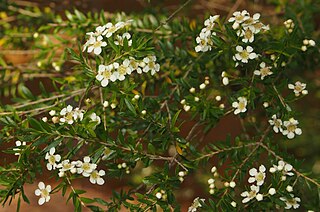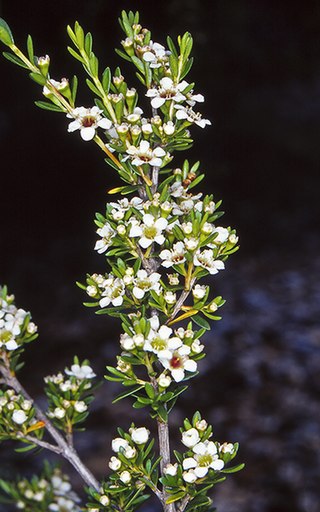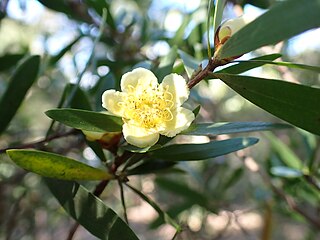
Leptospermum is a genus of shrubs and small trees in the myrtle family Myrtaceae commonly known as tea trees, although this name is sometimes also used for some species of Melaleuca. Most species are endemic to Australia, with the greatest diversity in the south of the continent, but some are native to other parts of the world, including New Zealand and Southeast Asia. Leptospermums all have five conspicuous petals and five groups of stamens which alternate with the petals. There is a single style in the centre of the flower and the fruit is a woody capsule.

Leptospermum continentale, commonly known as prickly tea-tree, is a species of slender, straggling shrub that is endemic to south-eastern Australia. It has sharp-pointed, narrowly egg-shaped leaves, white flowers arranged singly in leaf axils and woody fruit that remains on the plant when mature.

Leptospermum polygalifolium, commonly known as tantoon, jellybush or yellow tea tree, is a species of shrub or tree of the family Myrtaceae that is endemic to eastern Australia, including Lord Howe Island. It has thin bark, elliptical leaves, white flowers arranged singly on short side shoots and fruit that remain on the plant for a few years.

Leptospermum deuense is a species of shrub that is endemic to New South Wales. It is a leafy, densely branched shrub with rough bark on the older stems, elliptical leaves with a glossy upper surface, white flowers arranged singly or in pairs and woody fruit.
Babingtonia maleyae, commonly known as the Narrogin babingtonia, is a species of flowering plant in the family Myrtaceae and is endemic to the southwest of Western Australia. It is a compact shrub with narrowly egg-shaped to elliptic leaves and white flowers usually arranged singly in leaf axils, each flower with 17 to 20 stamens.
Babingtonia minutifolia is a species of flowering plant in the family Myrtaceae and is endemic to a small area in the southwest of Western Australia. It is an erect, widely spreading shrub with narrowly egg-shaped to elliptic leaves and pale pink flowers arranged singly in leaf axils, each flower with 16 to 19 stamens in a circle.

Babingtonia pelloeae, commonly known as Pelloe's babingtonia, is a species of flowering plant in the family Myrtaceae and is endemic to the southwest of Western Australia. It is an erect shrub with narrowly oblong to linear leaves and pink flowers usually arranged singly in leaf axils, each flower with 12 to 20 stamens in a circle.
Babingtonia urbana, commonly known as coastal plain babingtonia, is a species of flowering plant in the family Myrtaceae and is endemic to the southwest of Western Australia. It is a shrub with linear leaves and white or pale pink flowers usually arranged singly in leaf axils, each flower with 16 to 20 stamens in a circle.

Leptospermum coriaceum, commonly known as green tea-tree or mallee teatree, is a shrub species that is endemic to south-eastern and south-central Australia. It has smooth bark on the younger stems, elliptic to narrow egg-shaped leaves, white flowers and woody fruit. The usual habitat is mallee on sand dunes.

Leptospermum argenteum, commonly known as the Mt Royal tea-tree, is a species of shrub that is endemic to the higher parts of Barrington Tops in New South Wales. It has smooth bark, stems with a flange along the sides, broad leaves, white flowers and unlike many others in the genus, it is never lemon-scented.

Leptospermum blakelyi is a species of shrub that is endemic to rocky clifftops near Lithgow in New South Wales. It has densely silky young stems, egg-shaped to elliptical leaves and white or pink flowers.

Leptospermum brachyandrum is a species of shrub or small tree that is endemic to eastern Australia. It has smooth bark, linear to lance-shaped leaves and white flowers and usually grows along creeks, often in water.

Leptospermum neglectum is a shrub or small tree that is endemic to Queensland. It has elliptical leaves that are silky-hairy at first, white flowers on short shoots in leaf axils and fruit with the remnants of the sepals attached but that fall from the plant shortly after the seeds are released.

Leptospermum sejunctum is a shrub that is endemic to the Nowra district in New South Wales. It has thin, grey bark, lance-shaped to elliptical leaves, white flowers and fruit that remain on the plant at maturity.
Leptospermum speciosum is a species of shrub that is endemic to eastern Australia. It has pale bark that is shed in strips, broadly lance-shaped to elliptical leaves, white flowers arranged singly or in groups of up to three in leaf axils, and small, woody fruit that falls off when mature.
Baeckea kandos is a species of flowering plant in the family Myrtaceae and is endemic to a restricted area of New South Wales. It is a spreading shrub with narrow egg-shaped to linear leaves and small white flowers with ten to twelve stamens.

Baeckea latifolia is a species of flowering plant in the family Myrtaceae and is endemic to south-eastern continental Australia. It is a shrub with broadly elliptic leaves and small white flowers with six to eight stamens.

Neofabricia myrtifolia is a species of flowering plant in the family Myrtaceae, and is endemic to Queensland. It is a shrub or small tree with lance-shaped or egg-shaped leaves, the narrower end towards the base, yellow flowers borne singly in leaf axils with many stamens, and more or less cup-shaped fruits.

Neofabricia mjoebergii is a species of flowering plant in the family Myrtaceae, and is endemic to Cape York Peninsula in Queensland. It is a shrub or small tree with narrowly elliptic, sometimes lance-shaped or egg-shaped leaves with the narrower end towards the base, white or cream-coloured flowers usually borne singly in leaf axils, and broadly conical fruits.
Neofabricia sericisepala is a species of flowering plant in the family Myrtaceae, and is endemic to Cape York Peninsula in Queensland. It is a shrub or small tree with lance-shaped leaves with the narrower end towards the base, or narrowly elliptic, with yellow flowers borne singly in leaf axils, and broadly cup-shaped fruits.














